
reviewed by BETH WILLIAMSON
Charles Rennie Mackintosh (1868-1928) and the importance of his achievements in art, design and architect are well-rehearsed. This new book concerns his masterwork, the Glasgow School of Art, the Mackintosh building (the Mack of its title), its beginnings, its history, and its heartbreaking misfortunes in recent years. When a fire badly damaged the west end of the building on 23 May 2014, no one could have predicted that as the £35m restoration programme was nearing completion, tragedy would strike again when, on 15 June 2018, a second fire consumed the Mack once more. The emotional outpouring around these events, from staff, students, alumni, local people, and art lovers worldwide, demonstrates the enduring importance of the Mack, its resilience as a building and part of an institution. It is a monument of international significance in the history of design and architecture.
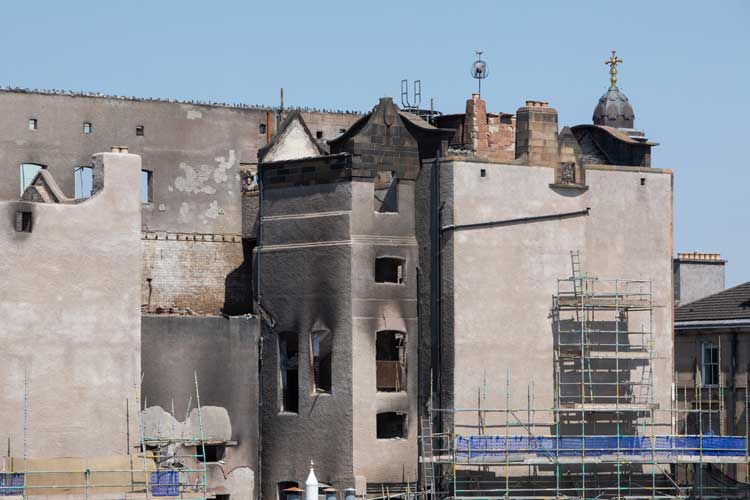
The Glasgow School of Art Mackintosh Building, 11 July 2018, with finial still in situ. McAteer Photograph.
This book, written and researched by the cultural historian Robyne Calvert, is a testament to the importance of the Mack for those who encounter it. Calvert, who specialises in the art, architecture, design and fashion of the 19th and early 20th centuries, was the Mackintosh Research Fellow at Glasgow School of Art from 2015 to 2021, so could not be better placed to write the story of this building and bring it entirely up to date. This is a multilayered history of the Mack that interweaves architectural history with art and design history, material culture studies, heritage studies, archaeology and social history to skilfully reveal the rich history of the building in new and fascinating ways.
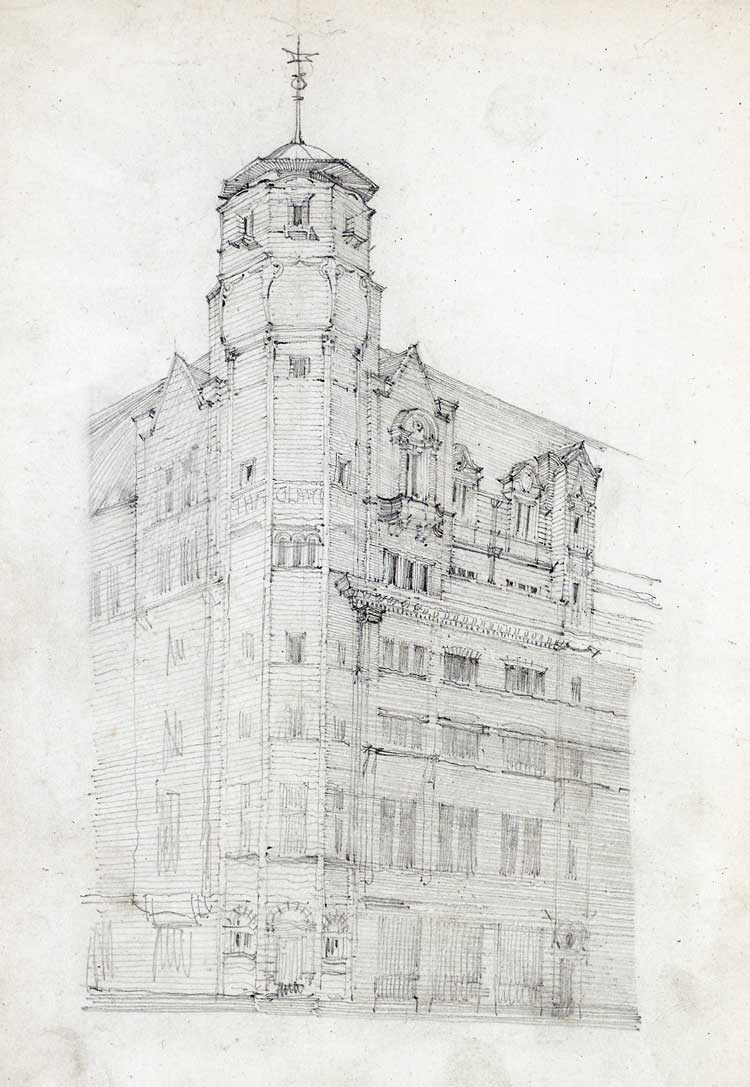
Charles Rennie Mackintosh for Honeyman & Keppie, Perspective drawing of the Glasgow Herald Building (now The Lighthouse Centre for Design), 1893. Glasgow School of Art Archives & Collections.
Glasgow School of Art began life as the Glasgow Government School of Design in 1845. The industrial revolution meant that Glasgow needed an art school to provide trained artisans who could contribute to social and economic growth. In 1893, Mackintosh borrowed the words of architect WR Lethaby for his own, claiming: “Modern architecture, to be real, must not be a mere envelope without contents.” For a building to be merely functional was not enough. The Mack was built in two phases in 1896-99 and 1907-09. This was a time when the Arts and Crafts movement, including figures such as John Ruskin, William Morris and Water Crane, considered strong artisanship as a way to improve social conditions for workers, rejecting industrial approaches to labour and manufacturing. The city was already alive with aestheticism and arts and crafts influences and the architectural history in this book is instructive and enthralling. Of course, the building alone was not enough and it was Glasgow School of Art’s director at the time, Francis Newbery, who established and grew the artistic community even before the building of the Mack became a necessity.
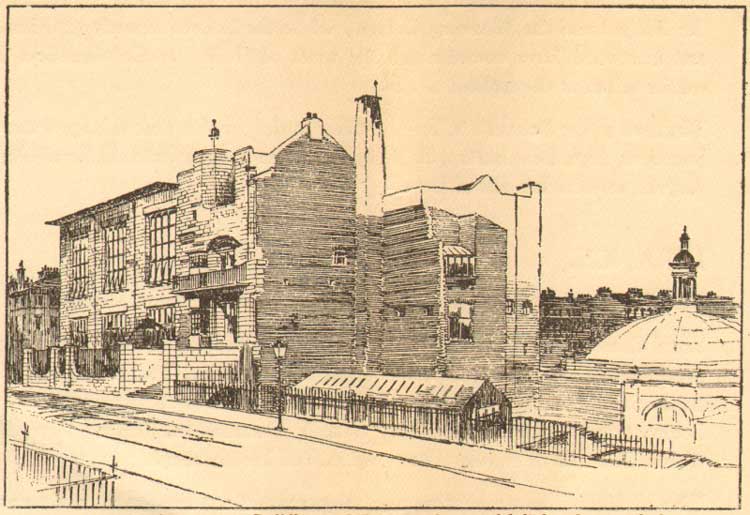
Alexander McGibbon. Sketch of Glasgow School of Art. Glasgow School of Art Archives &
Collections.
The architectural competition for the design of the Mack was launched in July 1896. Early in 1897 it was Mackintosh’s design, under the banner of Honeyman and Keppie architects, that was selected. Calvert leads the reader through from design to realisation with the available evidence and with some really enriching snippets along the way. Using drawings of the building, photographs and other archival material, Calvert takes the reader on a tour of its spaces and how they were used. Beginning with the “messier studios” in the basement, rising to architecture at ground level and on up to the life rooms on the first floor. The second-floor housed professors’ studios and the elegant sounding Glass Pavilion, a space that would be become known as the “hen run”. Readers will be breathless by the time they reach the top floor.
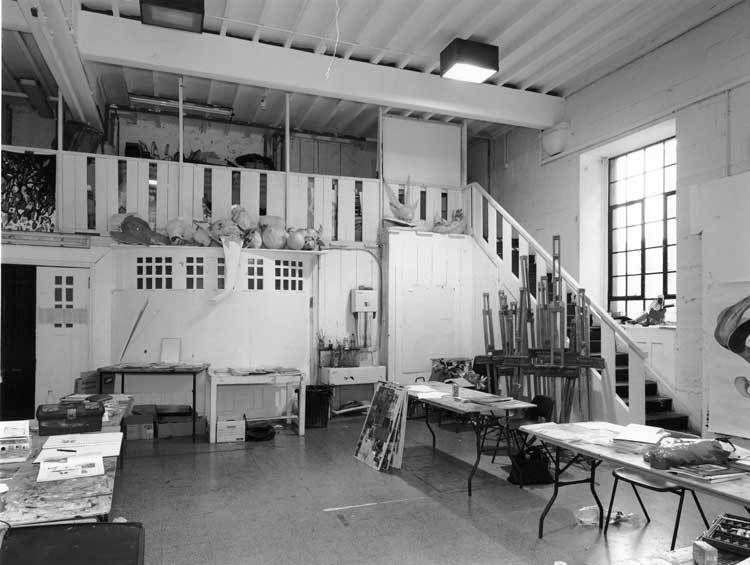
West basement studio with later mezzanine by Keppie Henderson. Glasgow School of Art Archives & Collections.
Calvert says the outside of the Mack is beguiling and she is right. The front and rear facades of the building are very different, an approach that Mackintosh often took and can be seen in other buildings he designed too. Something I really appreciate about this book is how a discussion of building materials and architecture sits comfortably alongside a consideration of design and other aspects of the building. For instance, the author dives into the different types of stone used for construction, iron work, building technology and techniques, historical models and influences, modern responses and contemporary conservation approaches. This is such rich writing and it flows beautifully, evoking the sights, sounds and smells within the Mack. It gently guides the reader through its fluid spaces, the library, the museum, lecture theatre, stairwells and studios.
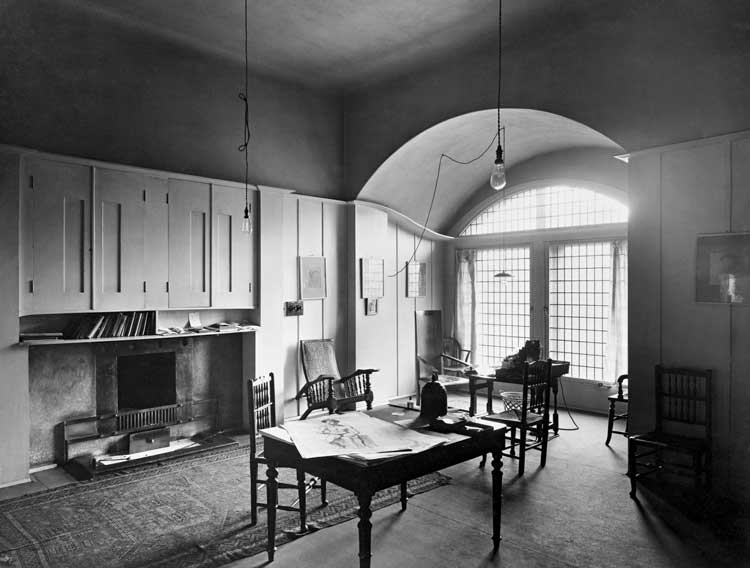
Bedford Lemere, Director’s Office, 1909. Glasgow School of Art Archives & Collections.
Originally, fire risk at the Glasgow School of Art was assuaged through building standards and compartmentalisation strategies. Yet as Calvert notes, many small fires erupted in the Mack throughout its history. Of the 2014 fire, she says: “What may have been an isolated incident turned into a disaster through ill-fated circumstances.” Calvert tells this sad litany of events before turning her attention to the bravery of the firefighters, the spirit and hope of staff and students, the recovery and rebuilding. That a second fire took hold in 2018 is almost beyond belief. Not only does Calvert examine both fires, but she discusses the conservation efforts and the public controversy surrounding the second fire. A rich array of images augment the book’s narrative, from historic and archival images to reconstruction photographs and visualisations using 3D scanning, and the images and text together present a comprehensive history of the building. A fresh understanding of the Mack is presented here, including new insights learned from the process of reconstruction which upend long-held assumptions. Calvert also contextualises the fires among others at Paris’s Notre Dame Cathedral in 2019 and, perhaps most importantly of all, the Grenfell fire in London in 2017. This sensitive handling of context deserves to be noted.
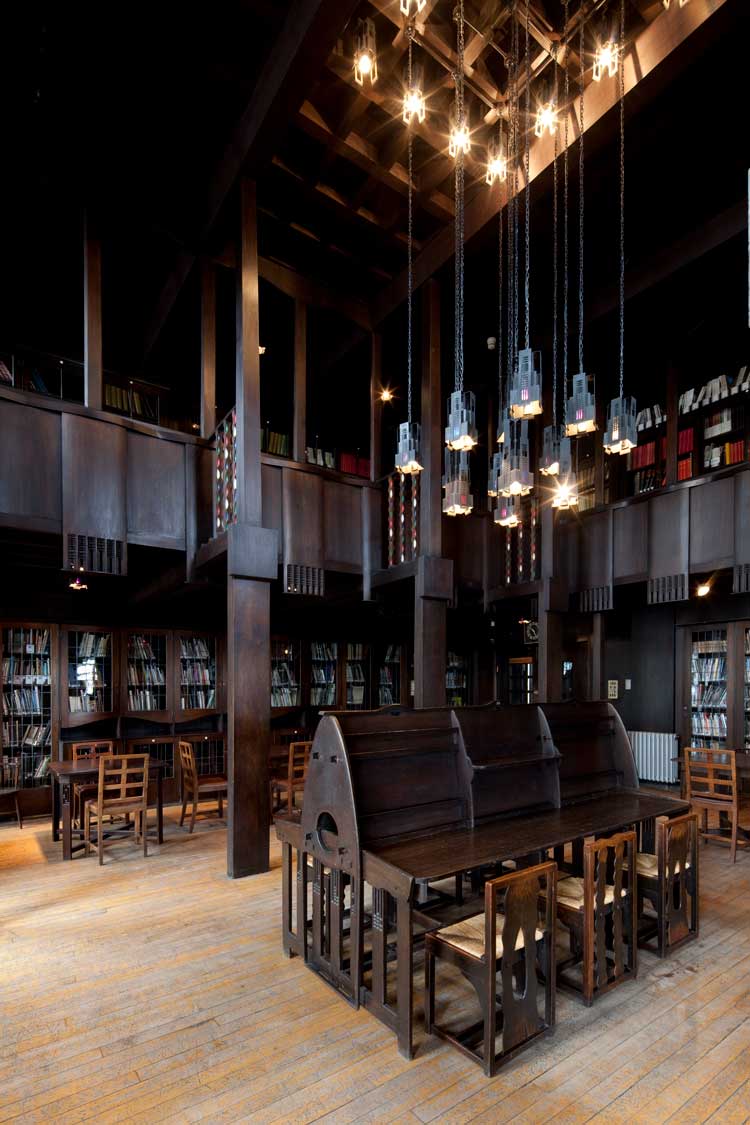
The Library from southwest corner. McAteer Photograph
Calvert’s epilogue is a fitting conclusion to her story of the Mack, and one that readers should discover for themselves. The key point is that in The Mack, Calvert interrogates the importance of Mackintosh’s masterwork, its international design significance, and its deep effect on the community of those connected to it in time and space. She executes that interrogation with rigour, with sensitivity and with heart. As she says: “The story the Mack tells is not just one of bricks and mortar, but of its overall effect on the people who have been part of its life, its death and, hopefully, its resurrection.” Long live the Mack.
• The Mack: Charles Rennie Mackintosh and the Glasgow School of Art, by Robyne Calvert, published by Yale University Press, price £35 (hardback), is out on 23 April 2024.
Slavs and Tatars: The Contest of the Fruits
Rapping fruit, legendary birds and nail art feature in the UK debut of the Berlin-based collective S...
Liverpool Biennial 2025: Bedrock
From Sheila Hicks’s gemstone-like sculptures to Elizabeth Price’s video essay on modernist Catho...
Mikhail Karikis – interview: ‘What is the soundscape of the forthcomin...
Mikhail Karikis explains the ideas behind his new sound and video installation calling for action ag...
Art & the Book* and Spineless Wonders: The Power of Print Unbound**
Two concurrent exhibitions bring special collections into broader spaces of circulation, highlightin...
Focusing on the skills of wallpaper design and embroidery, this exhibition tells the story of the ...
Daphne Wright: Deep-Rooted Things
This show is a celebration of the domestic, and the poignant sculpture of Wright’s two sons, now o...
Anna Boghiguian: The Sunken Boat: A Glimpse into Past Histories
The venerable Egyptian Canadian installation artist Anna Boghiguian brings shipwrecks, shells and th...
Abstract Erotic: Louise Bourgeois, Eva Hesse, Alice Adams
A groundbreaking New York show from 1966 is brought back to life with the work of three women whose ...
Jeremy Deller – interview: ‘I’m not looking for the next thing. I...
How did he go from asking a brass band to play acid house to filming former miners re-enacting a sem...
Encounters: Giacometti x Huma Bhabha
The first of three exhibitions to position historic sculptures by Alberto Giacometti with new works ...
The Parisian scenes that Edward Burra is known for are joyful and sardonic, but his work depicting t...
The 36th Ljubljana Biennale of Graphic Arts: The Oracle
Surprising, thrilling, enchanting – under the artistic direction of Chus Martínez, the works in t...
It’s Terrible the Things I Have to Do to Be Me: On Femininity and Fame ...
In a series of essays about pairs of famous women, the cultural critic Philippa Snow explores the co...
Paul Thek: Seized by Joy. Paintings 1965-1988
A rare London show of elusive queer pioneer Paul Thek captures a quieter side of his unpredictable p...
This elegantly composed exhibition celebrates 25 years’ of awards to female artists by Anonymous W...
The first of its kind, this vast show is a stunning tour of the realism movement of the 1920s and 30...
Maggi Hambling: ‘The sea is sort of inside me now … [and] it’s as if...
Maggi Hambling’s new and highly personal installation, Time, in memory of her longtime partner, To...
Caspar Heinemann takes us on a deep, dark emotional dive with his nihilistic installation that refer...
Complex, multilayered paintings and sculptures reek of the dark histories of slavery and colonialism...
Shown in the context of the historic paintings of Dulwich Picture Gallery, Rachel Jones’s new pain...
William Mackrell – interview: ‘I have an interest in dissecting the my...
William Mackrell's work has included lighting 1,000 candles and getting two horses to pull a car. No...
Marina Tabassum – interview: ‘Architecture is my life and my lifestyle...
The award-winning Bangladeshi architect behind this year’s Serpentine Pavilion on why she has shun...
A cabinet of curiosities – inside the new V&A East Storehouse
Diller Scofidio + Renfro has turned the 2012 Olympics broadcasting centre into a sparkling repositor...
Plásmata 3: We’ve met before, haven’t we?
This nocturnal exhibition organised by the Onassis Foundation’s cultural platform transforms a pub...
Ruth Asawa: Retrospective / Wayne Thiebaud: Art Comes from Art / Walt Disn...
Three well-attended museum exhibitions in San Francisco flag a subtle shift from the current drumbea...
This dazzling exhibition on the centenary of John Singer Sargent’s death celebrates his versatile ...
Through film, sound and dance, Emma Critchley’s continuing investigative project takes audiences o...
Rijksakademie Open Studios: Nora Aurrekoetxea, AYO and Eniwaye Oluwaseyi
At the Rijksakademie’s annual Open Studios event during Amsterdam Art Week, we spoke to three arti...
AYO – interview: Rijksakademie Open Studios
AYO reflects on her upbringing and ancestry in Uganda from her current position as a resident of the...
Eniwaye Oluwaseyi – interview: Rijksakademie Open Studios
Eniwaye Oluwaseyi paints figures, including himself, friends and members of his family, within compo...